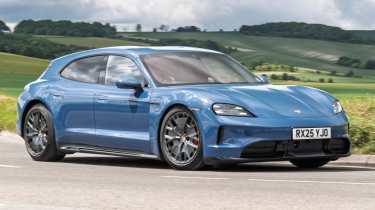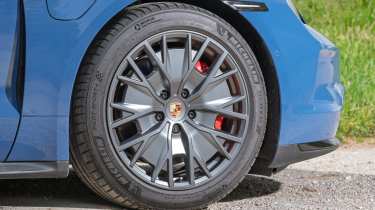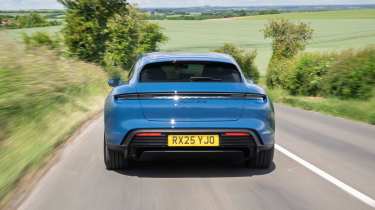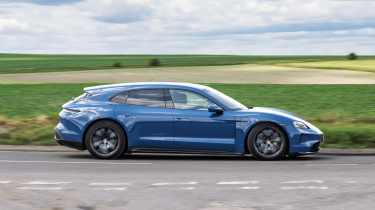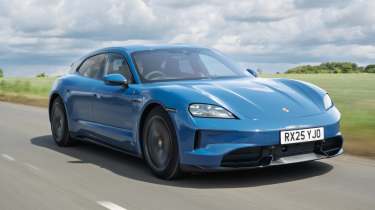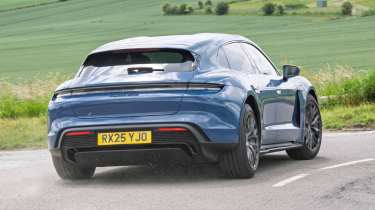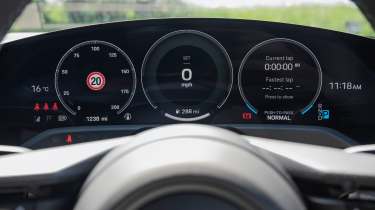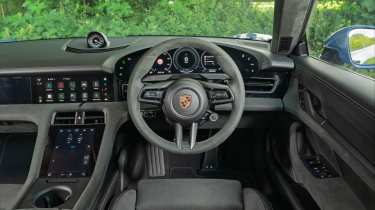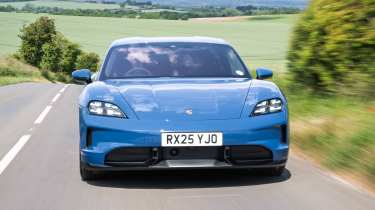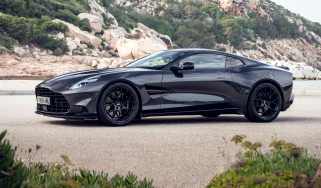Porsche Taycan GTS review – the sweet spot in the range renders a Turbo pointless
The Taycan GTS is superb in both saloon and Sport Turismo forms – it's the driver's choice for EVs right now
Just like when a new range of iPhones comes out with the mid-level model that’s faster and with a better camera than your four-year-old clanker, so too the revised Porsche Taycan range has produced a GTS that runs the previous Taycan Turbo close for anger and output. So just like when shopping for a new telecommunications device, the work of those without the misguided need for the biggest, best, most expensive model is to establish the sweet spot.
The £120k (starting) Taycan GTS Sport Turismo is all the electric Porsche you could reasonably ask for and renders the Pro-Maxed Turbo S superfluous in the real world. In fact, the GTS could for many be surplus to requirements over say, a bog-standard rear-driven Taycan. All told, it feels like the most honest expression of what the Taycan wants to be.
Powertrain, 0-62mph and technical highlights
- Active ride an option, air springs standard
- 690bhp with ‘overboost’, 597bhp the rest of the time
- 320kW charging and 384 miles claimed range
Spotting a GTS is fairly easy given the amount of black trim and the Sport Design body kit they will all come with. Inside it’s awash with Porsche’s Race-tex upholstery (akin to Alcantara) and there’s also the option of a new panoramic roof that can switch from clear to opaque at the press of a button.
For an extra grand, you can opt for the more versatile and arguably even more attractive Sport Turismo estate, as tested here. The Taycan casts a pretty large footprint at just under five metres long and almost two metres wide, but as ever, packing a large battery within that slender shape is a challenge. Time once was that we’d call a c/2300kg kerb weight shocking alongside the likes of say, an 1800kg BMW M5 CS. Now the weighty new M5 Touring is almost 200kg up on the Porsche.
More reviews
In-depth reviews
Review
Reviews
Such is progress, the new Taycan GTS still sits between the new 4S and Turbo in terms of power but at 690bhp and 585lb ft it only falls shy of the old Turbo S by a meagre 60bhp. The 597bhp it cuts about with off overboost is more than the 590bhp on overboost figure of the last-generation car.
Meanwhile its 0-62mph time is just 0.5sec slower than the last Turbo, at 3.3sec, and falls shy of its 0-124mph time by just 0.6sec, at 10.4sec. It occupies the same space in the range, it’s just that the output and performance of every Taycan has been taken up a step.
Porsche engineers always referred to the Turbo S as the power monster for the autobahn, but when it comes to driving, the GTS is the one they’re excited about. It also boasts a strong range of 384 miles combined, up from 313 miles claimed in the last Taycan GTS. That’s thanks to the new gen-2 hardware it shares with every Taycan, with lighter more efficient batteries that can also be charged quicker. Find a charger with enough punch and the GTS will suck up charge at a rate of 320kW, that it’ll arrive at pretty swiftly if sufficiently drained, to the point that pre-conditioning is almost obsolete.
An optional big change for the GTS, as per the rest of the range, is the inclusion of Active Ride suspension. The system utilises electro-hydraulically controlled active dampers to improve both the ride and body control and comes with a GTS-specific tune should you option them. We’d have been curious to sample it but our test car came with the conventional air suspension set-up that’s now standard and was optional on lower-spec pre-facelift Taycans.
The GTS has 20 percent stiffer anti-roll bars front and rear, and higher spring rates. The optional PDCC active anti-roll bars and rear-wheel steering have also been configured to suit. There are new wheel designs for the second-gen car, spanning 20 inches and 21 inches. The Aero Design wheels from the Turbo S and the optional 21-inch RS Spyder wheels come in anthracite grey for the GTS.
Performance, ride and handling
- As fast as you could want or need in the real world
- Agility aided by rear steering
- Fundamental rear balance still there with AWD
Even so, the acceleration is still of the absurd, gut-squeezing variety that’s now familiar with fast EVs. The GTS is all the car you could possibly want in terms of performance, outside of the realms of a YouTube drag race. Its four driven wheels and instant torque delivery muster a 0-62mph time of just 3.4 seconds.
There’s also a louder and unique ‘artificial engine noise’ in the cabin, which can at times sound a little like a V10 at low revs, as in the subtle resonant tones of the old C6-gen Audi RS6. It has a more obvious change in pitch than the usual Taycan’s starship whir, which gives the impression of different gears being used. This might read like we’re desperately searching for an element of soul to the GTS, and you might be right, but it’s amazing what a bit more noise can do to the driving experience. The product may artifice it augments the driver-car interplay all the same.
Like any Taycan, the GTS is an effortless long-distance cruiser. Switch the suspension to Comfort mode and it cruises serenely for the most part, swallowing uneven tarmac while minimising the vertical float that’s so typical of heavy, air-sprung cars. The illusion breaks over certain high-frequency bumps though, and the GTS can suddenly feel disjointed as impacts tremor through the chassis.
This can’t be escaped in any of the three modes, with Sport and Sport Plus feeling more reactive over bumps that the GTS can otherwise take within its suspension travel. In the past we’d said that ‘for an EV’, the Taycan is well resolved. With hindsight and plenty of time behind the wheel of the new hybrid M5, that qualification changes to ‘for a heavy car’. Lighter saloons and estates on conventional springs have greater breadth and consistency.
What the electric element, particularly the regenerative system, is responsible for, is the wonky brake pedal feel. The low-speed calibration isn’t greatly improved, with the maintenance of braking rate still requiring adjustment of pedal pressure as regen hands over to friction braking. At speed, meanwhile, the pedal lacks the reassuring bite and modulation found in Porsche’s conventional performance cars.
If you find a decently surfaced road and dig deep within the Taycan’s abilities, it’s much harder to pick holes. The steering is superb. Details permeate through the thin rim and the rate of response is beautifully judged – and perhaps a hair quicker than you expect – giving the impression of huge potential even before you’ve got to the meat of a corner.
Once turned in the Taycan takes set, and it’s here where you feel the electronics massaging more performance from the car, in particular the rear-wheel steering. In long curves it’s subtly introduced when the front tyres threaten to slide, keeping the car nailed on your chosen path in what feels like sorcery.
It’s only really through hard, deliberate inputs – those that you’ll hardly be making on the road, it must be said – that the Taycan’s mass feels overbearing. Hustle it through a direction change or barrel into a corner too quickly and yes, the weight reveals itself.
But the GTS can still live with an uncanny level of commitment for such a heavy car, tucking into apexes on a trailing brake and firing out the other side in a blink, sometimes with a quarter turn of opposite lock. The thrust when you get on the throttle doesn’t feel disproportionate to the cornering potential of the GTS either, which goes some way in making it feel like a cohesive driver’s car.
The dynamic nuance and sheer ability of the Taycan GTS was a huge achievement on launch. That its ability has endured in its impressiveness with minimal changes (remember, our car was more powerful but lacked the game-changing Active Ride system) is telling. This is a superb driving machine, EV or otherwise.
Driver’s note
‘I was skeptical, getting into the Taycan GTS, that it would present an argument for paying £30k extra over a standard RWD Taycan. The performance is more than you could possibly need, but the AWD adds capability and a road-munching ability. Rather than flinging sideways the GTS takes a 911 Turbo esque attitude, leaning hard, gripping, always with its nose pointing in your chosen direction with near telepathic accuracy. The standard RWD is better value but the GTS is, I think, the best expression of what the Taycan wants to be.’
Range and charging
- 300 miles of real driving possible with care in mild weather
- High-speed charging is welcome
- Near-instant uptake of high-rate charge equally so
If the Taycan GTS’s offering is ‘more of the same’ in terms of dynamics and performance, when not on the new Active Ride suspension at least, the range and charging performance have been vastly improved. The 313-mile claimed range figure of the first GTS really isn’t that far off what’s possible for real in the new car.
Mild weather conditions help, but mashing on motorway miles really doesn’t. Driven thusly, in our experience the Taycan GTS was more or less dependable in its ability to cover 280-300 miles in the real world.
Then when it is time to juice up, its near-instant acceptance of 300kW from a speedy enough charger means adding 100 miles to the ‘tank’ is the work of a quick wee break. Grab a burger and a drink and that’ll be 200 miles. It’ll recuperate energy at up to 400kW when braking hard from high speeds too. The result of all this, operating in a world with marginally improved infrastructure to when the Taycan was first released, is that this is a more dependable car to really use.
If you’ve a driveway and plug in every night, twas ever thus but this is a car you can live with much more easily in 2025. That if anything lends credence to the general consensus that the first Taycan did arrive a couple of years too early and was not quite where it needed to be.
Interior and tech
- A great Porsche driving environment
- Digital ergonomics still wonky
- Quality is still high
The heavily digitised design is unimaginative but more importantly, an ergonomic pain. The controls for the climate control remain utterly infuriating too – adjusting the direction of airflow via a touch screen rather than with a toggle is as it ever was, totally nonsensical.
But the traditional ‘Porsche’ stuff is great. The Taycan’s is a fantastic driving environment, resolved with a typically teutonic quality in terms materials, fit and finish. The small, suede-trimmed wheel extends right out to meet you and the adaptive sports seat drop low – electric or not, this is recognisably a Porsche inside. There’s a genuine sense of purpose that doesn’t square with a c2300kg EV.
It’s pretty compact in the Taycan, though. You do sit low, there’s a 911-alike sense of being cocooned, the haunches visible up ahead lending to that sensation. The room in the front is fine though – there’s good head and legroom. The same can’t be said for the rear. Even in Sport Turismo form, the rear seats are tighter than they ought to be in a car as long as a 5-series.
Prices and rivals
Priced at £118,200 (£119,200 for the Sport Turismo) the GTS sits – you guessed it – halfway between the models on either side of it. It’s very much the driver’s choice in the Taycan range, though, whatever the price. The Audi S e-tron GT runs it closest in terms of performance and is roughly £10k cheaper. For £8k more than the GTS, you can have the 844bhp RS e-Tron GT. Neither can match the Taycan for steering tactility or a more natural sense of focus.
Rivals have come and gone for the Taycan. The Mercedes-AMG EQE 53 is hanging by a thread and the EQS 53 is off the configurator. Coming soon from Mercedes, the exciting next-generation AMG GT four-door, packing F1-inspired next-gen battery and motor tech, but that won’t be until next year. The Polestar 5 and Lotus Emeya are compelling alternatives you can buy now – the Emeya is £130k for the cheapest 900bhp version, while the Polestar is relatively good value, offering 737bhp and 416 miles of (WLTP) range for £89,500.
